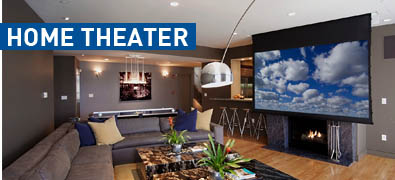ProjectorScreen.com: What new products/concepts are in the works for your Draper going forward that our readers will be
interested in learning about?
Draper: Although we can't give any specifics, our engineers are always working on finding new solutions to the changing needs of the projection
industry. We are constantly introducing new solutions, or upgrading existing ones to react to the changing needs of projection.
ProjectorScreen.com: What do you see as being the "Next Big Thing" from Draper?
Draper: The Scribe was mentioned above, but it bears discussion here as well. Particularly in education and higher ed, the Scribeoffers
some real benefits over competitive products.
We already mentioned the lower gloss levels to cut hotspotting and glare; the excellent clarity; and the better contrast.
All in all, the Scribe simply works better as a projection screen than similar products, which greatly increases the likelihood it will actually be used for its intended purpose, and not become just something to write notes on.
ProjectorScreen.com: What are some of the biggest mistakes that consumers make when purchasing projector screens?
Draper: The biggest mistake is in not buying a projection screen at all, but instead going with a flat panel display. Screens are available
in much larger sizes than TVs, so going with the supposedly easier choice of a TV means there will be people who can't see what's going on. It's as simple as that.
Another mistake is assuming that you can project onto a wall or just buy the cheapest screen and be OK. This is one of the pathways to another frequent problem we see: choosing the wrong screen surface for the job. When planning for a projection screen,
it is important to take into accounts all aspects of the installation: light on the screen, light over the viewers, projector model, location of the viewers, and the content to be projected. If you go cheap the quality will suffer.
Another issue we see is people not planning for the ceiling height. You need to make sure there is enough black drop to bring the bottom edge of the viewing area down to 48" above the finished floor.
Draper has a
Surface Selector tool on our website to help you figure out which viewing surface is right for the job, and properly size the screen. We also have a pro version
that narrows it down even further. You have to register to use the
pro version, but it is free. By choosing a screen that is big enough and designed for the application, you can often save money while making sure everyone sees and comprehends
your content.
ProjectorScreen.com: What tips can your offer to consumers looking to purchase projector screens?
Draper:

Understand where you want to put the screen, and research how to get the best image based on your area. Make sure the screen is sized to the viewing distance, rather than the size of the wall. You want a screen that is big enough, but not too large;
it can cause eye and neck strain, and eventually make using your theater undesirable. A properly sized screen allows you to take in all the action, focus on what is necessary, and enjoy the experience.